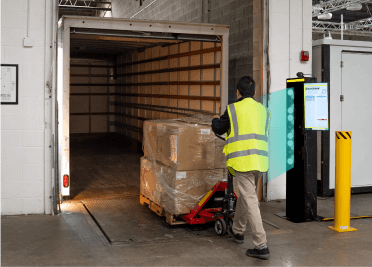Identify Paper-Based Processes and Data That Can Benefit from Enterprise Mobility
The problem with paper-based processes is that documents can easily get lost, especially as they’re passed back and forth within large organizations. From corpmagazine.com:
- $8 billion is spent annually on paper management.
- It costs organizations $20 to file a document, $120 to find a misplaced document, and $220 to reproduce a lost document.
- Each year, the amount of data businesses creates increases by 65%.
Within your organization, enterprise mobility can be used to improve the employee onboarding process. Instead of having new hires fill out paperwork, enterprise mobility allows that information to be collected quickly and accurately. Data delivery to departments like payroll and HR is instantaneous.
Out in the field, enterprise mobility can be used to collect customer signatures upon delivery, scan products as they leave the warehouse facility, or to protect sensitive data such as healthcare information or credit card numbers.
Look at the areas in your organization that still relies on pen and paper. Can they – and the data they generate – be made more efficient with enterprise mobility?
How SOTI Helps with This Resolution
SOTI Snap lets you make the apps you need to collect and share critical data. With an incredibly easy to use drag and drop interface, you can digitize your pen and paper processes in literally minutes without spending a fortune on developers.
Develop Key Performance Indicators (KPIs)
According to the Racing Toward the Future of Enterprise Mobility Report, nearly 10% of organizations are spending more than $500,000 on developing and deploying mobile devices.
If you’re investing in enterprise mobility, you should have KPIs in place to determine its effectiveness. KPIs can be divided into two categories: objective and subjective.
- Objective data will measure enterprise mobility performance using numbers. If time to complete a task drops from 30 minutes to 15, that’s an objective statistic.
- Subjective data is more personal in nature and isn’t measured in numbers. Instead of looking at analytics, subjective information comes from things like customer interviews and surveys.
With that in mind, here are some KPIs you should monitor:
- App adoption rate: From the enterprise mobility report, 21% of organizations spend more than $100,000 in app development. By measuring adoption rate, you’ll know how many mobile workers are downloading and using the apps you’re heavily investing in.
- User satisfaction: Ask mobile workers what they think of your enterprise mobility strategy and see if you can identify common words or phrases. Are they saying things like “it’s great”, “easy-to-use” and “time saving?” Or are they responding with things like “complicated”, “confusing”, and “frustrating?”
- Productivity and usage: Enterprise mobility should decrease the time and effort it takes for employees to complete tasks. For example, does an error message appear at a certain step? Is device battery life shorter than expected? With this information, you can modify and improve your mobile strategy as needed.
How SOTI Helps with This Resolution
SOTI Insight gives you greater visibility into the performance and profitability of your mobile assets. Keep track of critical data like app usage, data usage and device location to make smarter, more informed decisions about your enterprise mobility.
Integrate Your Legacy Systems to Modern Enterprise Mobility
CIO Insight calls legacy systems “the Achilles’ Heel of digital transformation.”
If you’ve been putting off legacy system integration because it’s too hard, too time consuming and too expensive, NOW is the time to make it happen.
By not connecting legacy systems to emerging technology (particularly mobile), you risk losing and misusing critical business data and processes.
Operating systems (OS) are always being updated or retired. In the past few years, we’ve seen and new BYOD-friendly URL enrollment introduced in iOS 13.
Integrating your legacy systems does more than just improve the efficiency of your enterprise mobility. It ensures that devices, endpoints and data are secure, and that your organization is compliant with ISO 27001 certification.
How SOTI Helps with This Resolution
SOTI MobiControl helps you manage legacy devices and systems with ease. Whether you want to maintain your current setup, or if you need to modernize devices and operating systems, SOTI MobiControl gives you the tools to do what’s best suited to your mobility needs.
Simplify
If enterprise mobility is critical to business success, shouldn’t it be easy to implement and intuitive to execute?
As business mobility and the Internet of Things continue to expand, more demands will be placed on your IT staff.
The best way to ensure this, is to consolidate the various platforms they’re using. Instead of having to switch from one platform for, say, app development and another platform for mobile device management, a single solution will make a tremendous difference in the time, effort and costs associated with your enterprise mobility strategy.
Simplification benefits just about any business in any industry, including:
- Emergency healthcare
- Field services
- Government
- Retail
- Transportation and logistics
Look at how you’re currently handling enterprise mobility and ask yourself if it’s as smooth and seamless as it should be. If it isn’t, and if your business is suffering because of it, then a change is necessary.
How SOTI Helps with This Resolution
The SOTI ONE Platform connects everything your business mobility needs to reduce the cost, complexity and downtime of your business-critical mobility. App development. Analytics. Mobile diagnostics. IoT device management. Access to product experts. The SOTI ONE Platform simplifies and unifies your enterprise mobility requirements.
Ready to Start? We’re Ready to Help!
To learn more, contact our AbeTech Solution Experts today!










